Internal vs. External Auditors: Functions, Roles, and Differences
VerifiedAdded on 2020/05/11
|16
|5605
|65
Report
AI Summary
This report provides a comprehensive comparison of internal and external auditors, examining their distinct roles and responsibilities within a business organization. It begins by defining the rationale for auditing and highlights the importance of both internal and external auditors in ensuring the accuracy of financial statements. The report then outlines the research problem, objectives, and questions, setting the stage for a detailed literature review. The literature review explores the functions of external auditors, including their independence and the types of audit opinions they issue. It also discusses the role of internal auditors in evaluating internal controls, risk management, and governance. The report emphasizes the connection between the two auditor types, highlighting the external auditor's reliance on the internal auditor's reports. Finally, the report concludes by summarizing the key differences and connections between internal and external auditors, emphasizing their complementary roles in maintaining financial integrity.
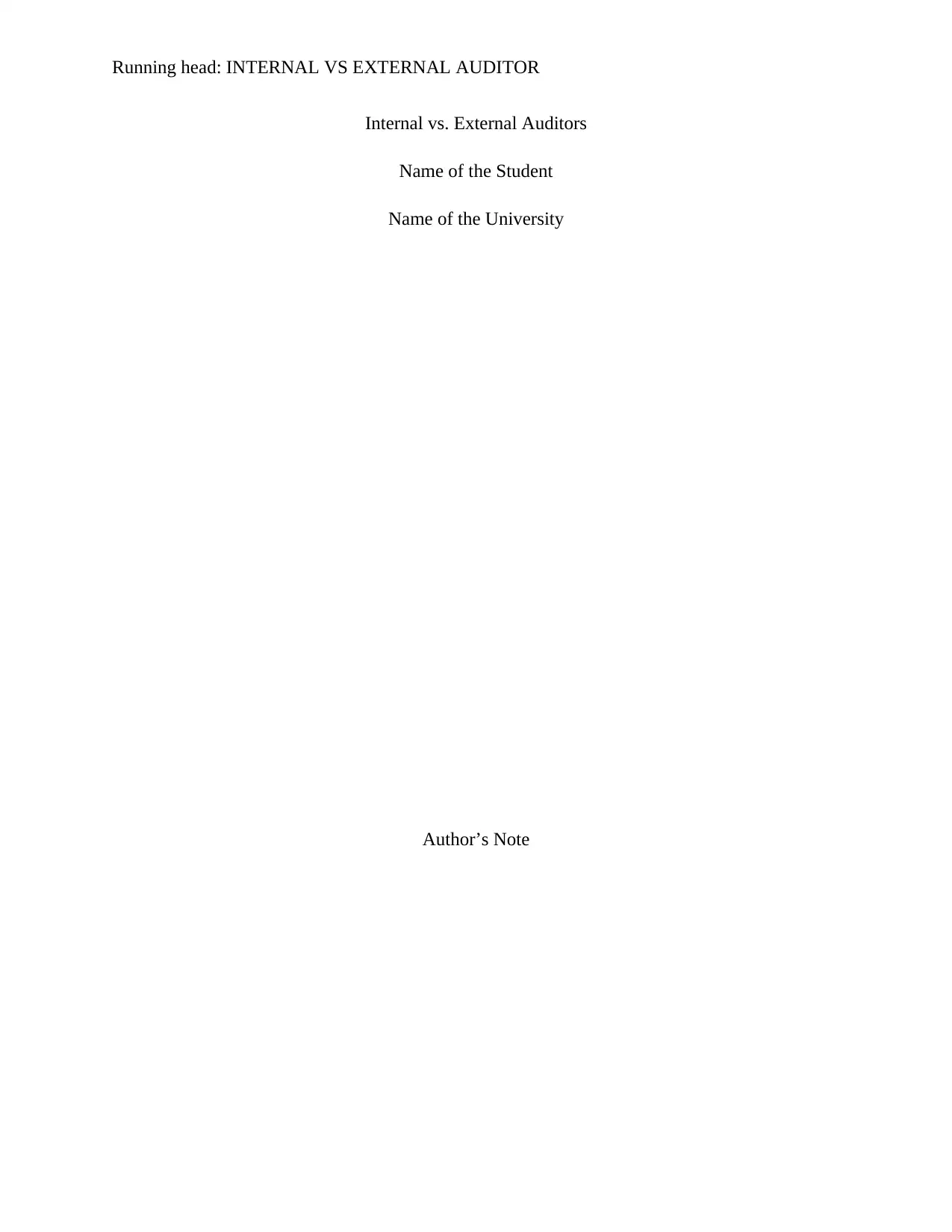
Running head: INTERNAL VS EXTERNAL AUDITOR
Internal vs. External Auditors
Name of the Student
Name of the University
Author’s Note
Internal vs. External Auditors
Name of the Student
Name of the University
Author’s Note
Paraphrase This Document
Need a fresh take? Get an instant paraphrase of this document with our AI Paraphraser
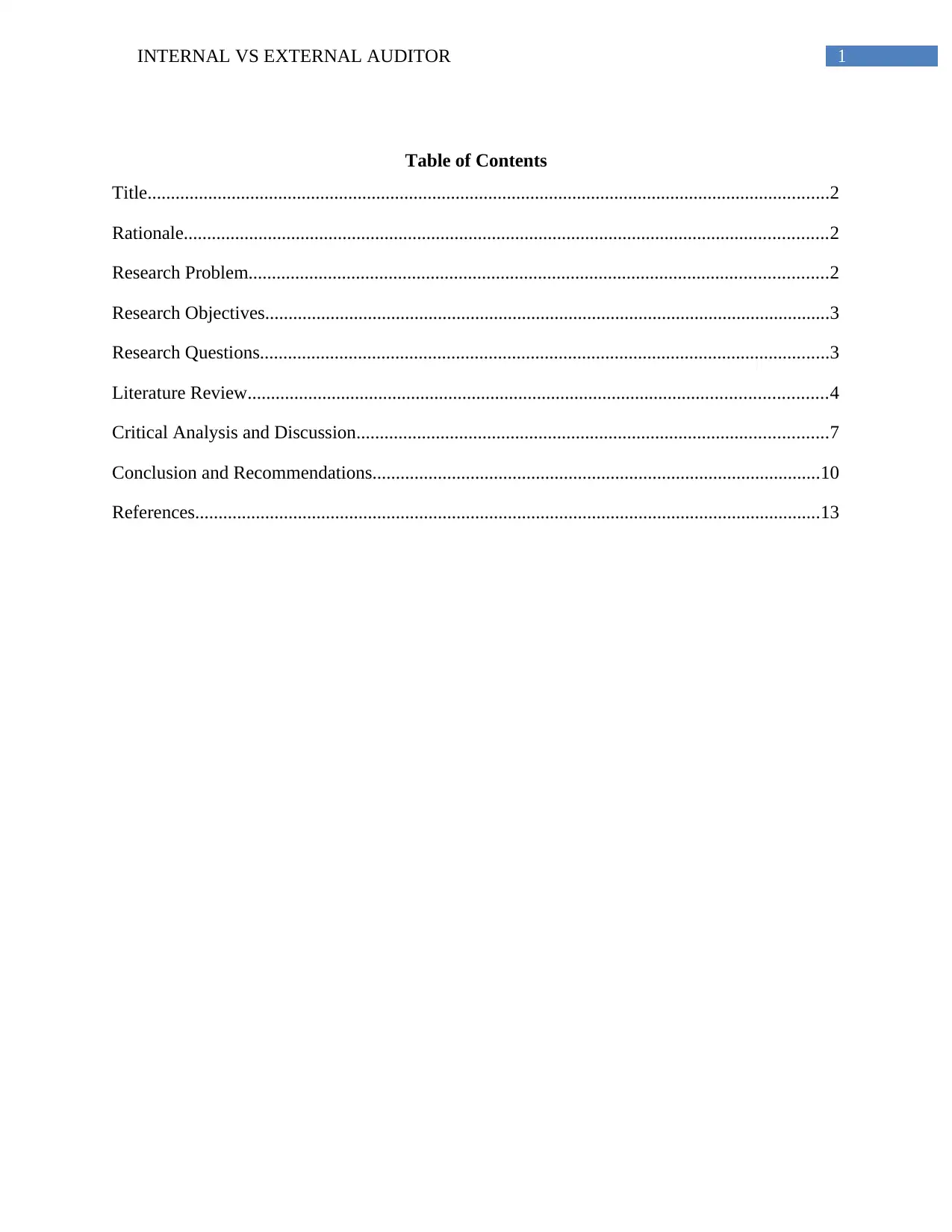
1INTERNAL VS EXTERNAL AUDITOR
Table of Contents
Title..................................................................................................................................................2
Rationale..........................................................................................................................................2
Research Problem............................................................................................................................2
Research Objectives.........................................................................................................................3
Research Questions..........................................................................................................................3
Literature Review............................................................................................................................4
Critical Analysis and Discussion.....................................................................................................7
Conclusion and Recommendations................................................................................................10
References......................................................................................................................................13
Table of Contents
Title..................................................................................................................................................2
Rationale..........................................................................................................................................2
Research Problem............................................................................................................................2
Research Objectives.........................................................................................................................3
Research Questions..........................................................................................................................3
Literature Review............................................................................................................................4
Critical Analysis and Discussion.....................................................................................................7
Conclusion and Recommendations................................................................................................10
References......................................................................................................................................13
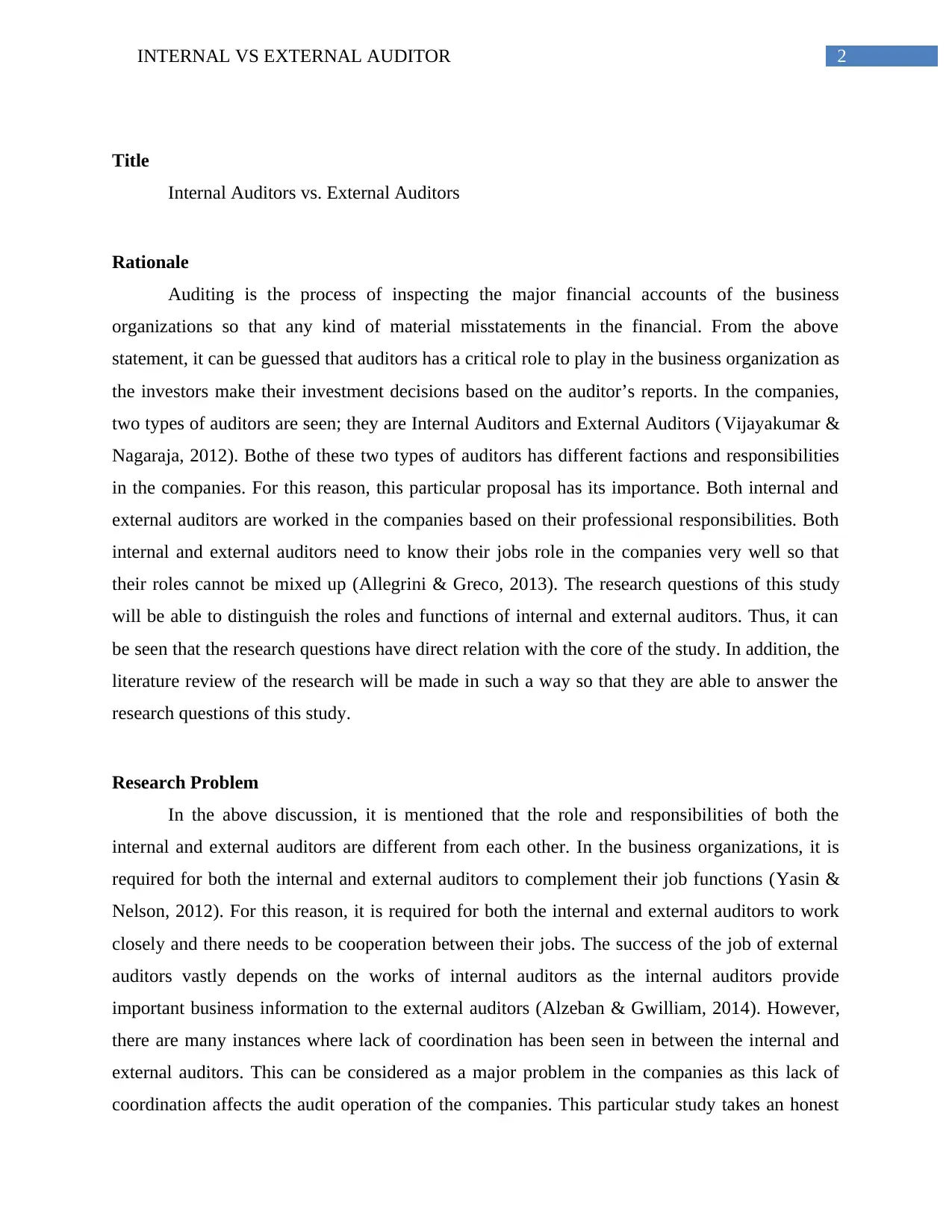
2INTERNAL VS EXTERNAL AUDITOR
Title
Internal Auditors vs. External Auditors
Rationale
Auditing is the process of inspecting the major financial accounts of the business
organizations so that any kind of material misstatements in the financial. From the above
statement, it can be guessed that auditors has a critical role to play in the business organization as
the investors make their investment decisions based on the auditor’s reports. In the companies,
two types of auditors are seen; they are Internal Auditors and External Auditors (Vijayakumar &
Nagaraja, 2012). Bothe of these two types of auditors has different factions and responsibilities
in the companies. For this reason, this particular proposal has its importance. Both internal and
external auditors are worked in the companies based on their professional responsibilities. Both
internal and external auditors need to know their jobs role in the companies very well so that
their roles cannot be mixed up (Allegrini & Greco, 2013). The research questions of this study
will be able to distinguish the roles and functions of internal and external auditors. Thus, it can
be seen that the research questions have direct relation with the core of the study. In addition, the
literature review of the research will be made in such a way so that they are able to answer the
research questions of this study.
Research Problem
In the above discussion, it is mentioned that the role and responsibilities of both the
internal and external auditors are different from each other. In the business organizations, it is
required for both the internal and external auditors to complement their job functions (Yasin &
Nelson, 2012). For this reason, it is required for both the internal and external auditors to work
closely and there needs to be cooperation between their jobs. The success of the job of external
auditors vastly depends on the works of internal auditors as the internal auditors provide
important business information to the external auditors (Alzeban & Gwilliam, 2014). However,
there are many instances where lack of coordination has been seen in between the internal and
external auditors. This can be considered as a major problem in the companies as this lack of
coordination affects the audit operation of the companies. This particular study takes an honest
Title
Internal Auditors vs. External Auditors
Rationale
Auditing is the process of inspecting the major financial accounts of the business
organizations so that any kind of material misstatements in the financial. From the above
statement, it can be guessed that auditors has a critical role to play in the business organization as
the investors make their investment decisions based on the auditor’s reports. In the companies,
two types of auditors are seen; they are Internal Auditors and External Auditors (Vijayakumar &
Nagaraja, 2012). Bothe of these two types of auditors has different factions and responsibilities
in the companies. For this reason, this particular proposal has its importance. Both internal and
external auditors are worked in the companies based on their professional responsibilities. Both
internal and external auditors need to know their jobs role in the companies very well so that
their roles cannot be mixed up (Allegrini & Greco, 2013). The research questions of this study
will be able to distinguish the roles and functions of internal and external auditors. Thus, it can
be seen that the research questions have direct relation with the core of the study. In addition, the
literature review of the research will be made in such a way so that they are able to answer the
research questions of this study.
Research Problem
In the above discussion, it is mentioned that the role and responsibilities of both the
internal and external auditors are different from each other. In the business organizations, it is
required for both the internal and external auditors to complement their job functions (Yasin &
Nelson, 2012). For this reason, it is required for both the internal and external auditors to work
closely and there needs to be cooperation between their jobs. The success of the job of external
auditors vastly depends on the works of internal auditors as the internal auditors provide
important business information to the external auditors (Alzeban & Gwilliam, 2014). However,
there are many instances where lack of coordination has been seen in between the internal and
external auditors. This can be considered as a major problem in the companies as this lack of
coordination affects the audit operation of the companies. This particular study takes an honest
⊘ This is a preview!⊘
Do you want full access?
Subscribe today to unlock all pages.

Trusted by 1+ million students worldwide
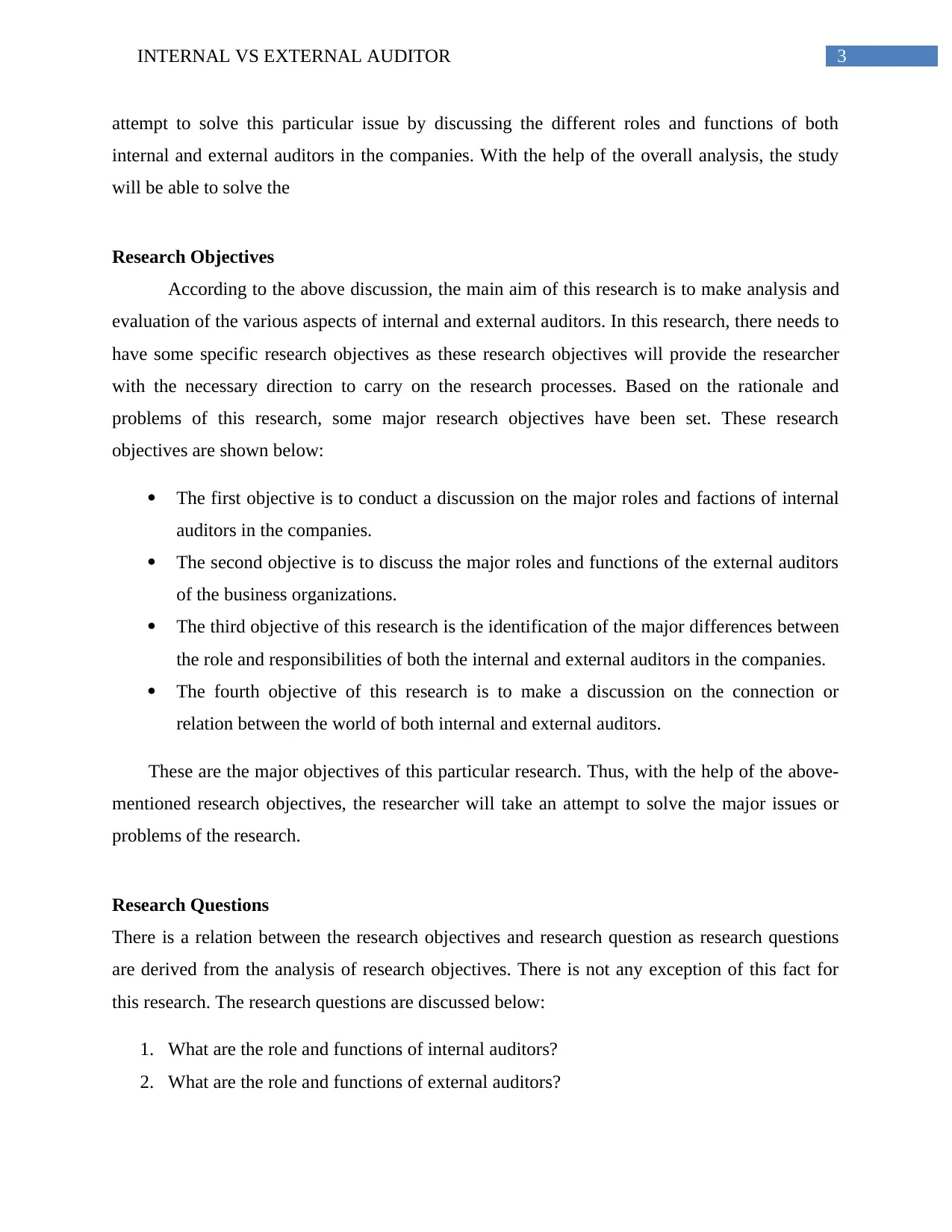
3INTERNAL VS EXTERNAL AUDITOR
attempt to solve this particular issue by discussing the different roles and functions of both
internal and external auditors in the companies. With the help of the overall analysis, the study
will be able to solve the
Research Objectives
According to the above discussion, the main aim of this research is to make analysis and
evaluation of the various aspects of internal and external auditors. In this research, there needs to
have some specific research objectives as these research objectives will provide the researcher
with the necessary direction to carry on the research processes. Based on the rationale and
problems of this research, some major research objectives have been set. These research
objectives are shown below:
The first objective is to conduct a discussion on the major roles and factions of internal
auditors in the companies.
The second objective is to discuss the major roles and functions of the external auditors
of the business organizations.
The third objective of this research is the identification of the major differences between
the role and responsibilities of both the internal and external auditors in the companies.
The fourth objective of this research is to make a discussion on the connection or
relation between the world of both internal and external auditors.
These are the major objectives of this particular research. Thus, with the help of the above-
mentioned research objectives, the researcher will take an attempt to solve the major issues or
problems of the research.
Research Questions
There is a relation between the research objectives and research question as research questions
are derived from the analysis of research objectives. There is not any exception of this fact for
this research. The research questions are discussed below:
1. What are the role and functions of internal auditors?
2. What are the role and functions of external auditors?
attempt to solve this particular issue by discussing the different roles and functions of both
internal and external auditors in the companies. With the help of the overall analysis, the study
will be able to solve the
Research Objectives
According to the above discussion, the main aim of this research is to make analysis and
evaluation of the various aspects of internal and external auditors. In this research, there needs to
have some specific research objectives as these research objectives will provide the researcher
with the necessary direction to carry on the research processes. Based on the rationale and
problems of this research, some major research objectives have been set. These research
objectives are shown below:
The first objective is to conduct a discussion on the major roles and factions of internal
auditors in the companies.
The second objective is to discuss the major roles and functions of the external auditors
of the business organizations.
The third objective of this research is the identification of the major differences between
the role and responsibilities of both the internal and external auditors in the companies.
The fourth objective of this research is to make a discussion on the connection or
relation between the world of both internal and external auditors.
These are the major objectives of this particular research. Thus, with the help of the above-
mentioned research objectives, the researcher will take an attempt to solve the major issues or
problems of the research.
Research Questions
There is a relation between the research objectives and research question as research questions
are derived from the analysis of research objectives. There is not any exception of this fact for
this research. The research questions are discussed below:
1. What are the role and functions of internal auditors?
2. What are the role and functions of external auditors?
Paraphrase This Document
Need a fresh take? Get an instant paraphrase of this document with our AI Paraphraser
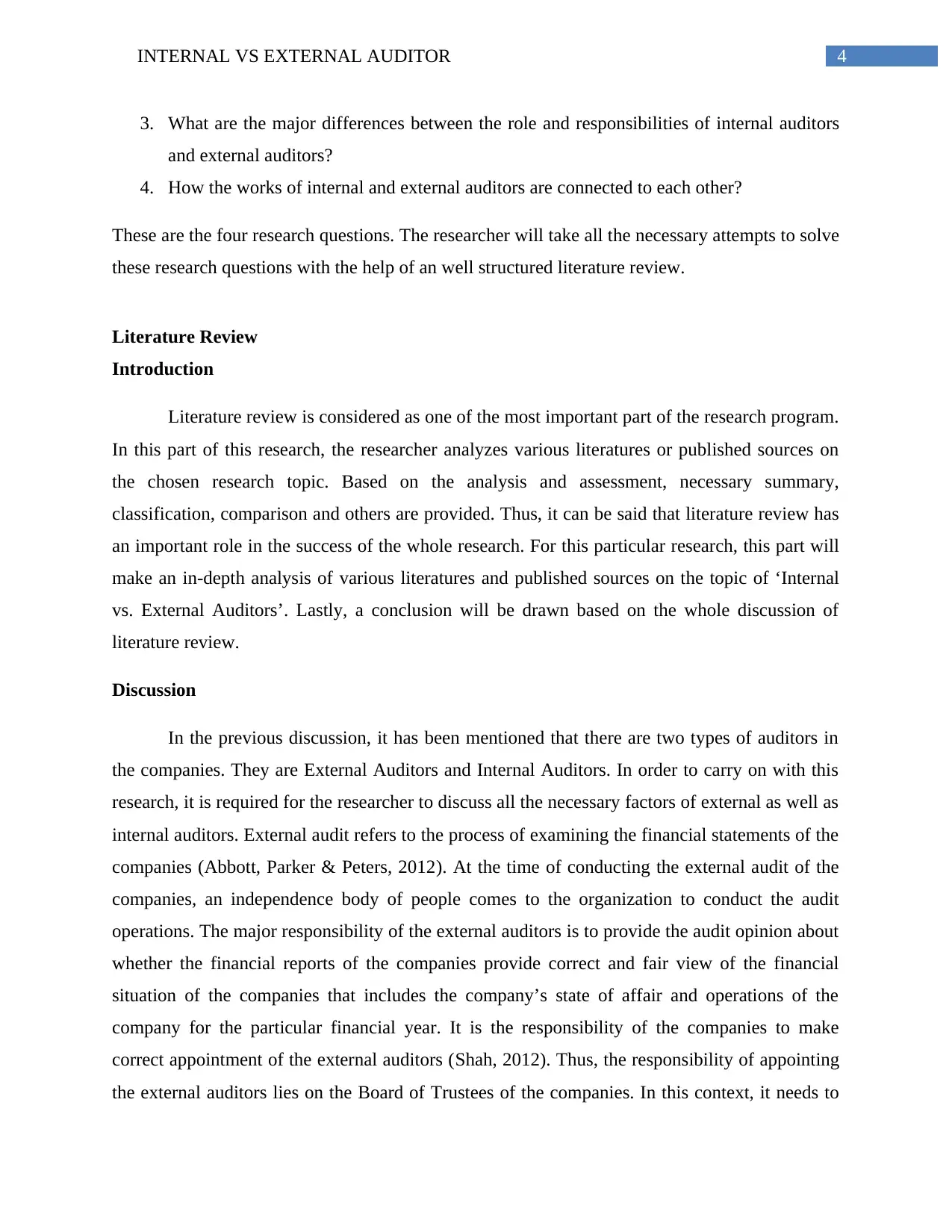
4INTERNAL VS EXTERNAL AUDITOR
3. What are the major differences between the role and responsibilities of internal auditors
and external auditors?
4. How the works of internal and external auditors are connected to each other?
These are the four research questions. The researcher will take all the necessary attempts to solve
these research questions with the help of an well structured literature review.
Literature Review
Introduction
Literature review is considered as one of the most important part of the research program.
In this part of this research, the researcher analyzes various literatures or published sources on
the chosen research topic. Based on the analysis and assessment, necessary summary,
classification, comparison and others are provided. Thus, it can be said that literature review has
an important role in the success of the whole research. For this particular research, this part will
make an in-depth analysis of various literatures and published sources on the topic of ‘Internal
vs. External Auditors’. Lastly, a conclusion will be drawn based on the whole discussion of
literature review.
Discussion
In the previous discussion, it has been mentioned that there are two types of auditors in
the companies. They are External Auditors and Internal Auditors. In order to carry on with this
research, it is required for the researcher to discuss all the necessary factors of external as well as
internal auditors. External audit refers to the process of examining the financial statements of the
companies (Abbott, Parker & Peters, 2012). At the time of conducting the external audit of the
companies, an independence body of people comes to the organization to conduct the audit
operations. The major responsibility of the external auditors is to provide the audit opinion about
whether the financial reports of the companies provide correct and fair view of the financial
situation of the companies that includes the company’s state of affair and operations of the
company for the particular financial year. It is the responsibility of the companies to make
correct appointment of the external auditors (Shah, 2012). Thus, the responsibility of appointing
the external auditors lies on the Board of Trustees of the companies. In this context, it needs to
3. What are the major differences between the role and responsibilities of internal auditors
and external auditors?
4. How the works of internal and external auditors are connected to each other?
These are the four research questions. The researcher will take all the necessary attempts to solve
these research questions with the help of an well structured literature review.
Literature Review
Introduction
Literature review is considered as one of the most important part of the research program.
In this part of this research, the researcher analyzes various literatures or published sources on
the chosen research topic. Based on the analysis and assessment, necessary summary,
classification, comparison and others are provided. Thus, it can be said that literature review has
an important role in the success of the whole research. For this particular research, this part will
make an in-depth analysis of various literatures and published sources on the topic of ‘Internal
vs. External Auditors’. Lastly, a conclusion will be drawn based on the whole discussion of
literature review.
Discussion
In the previous discussion, it has been mentioned that there are two types of auditors in
the companies. They are External Auditors and Internal Auditors. In order to carry on with this
research, it is required for the researcher to discuss all the necessary factors of external as well as
internal auditors. External audit refers to the process of examining the financial statements of the
companies (Abbott, Parker & Peters, 2012). At the time of conducting the external audit of the
companies, an independence body of people comes to the organization to conduct the audit
operations. The major responsibility of the external auditors is to provide the audit opinion about
whether the financial reports of the companies provide correct and fair view of the financial
situation of the companies that includes the company’s state of affair and operations of the
company for the particular financial year. It is the responsibility of the companies to make
correct appointment of the external auditors (Shah, 2012). Thus, the responsibility of appointing
the external auditors lies on the Board of Trustees of the companies. In this context, it needs to
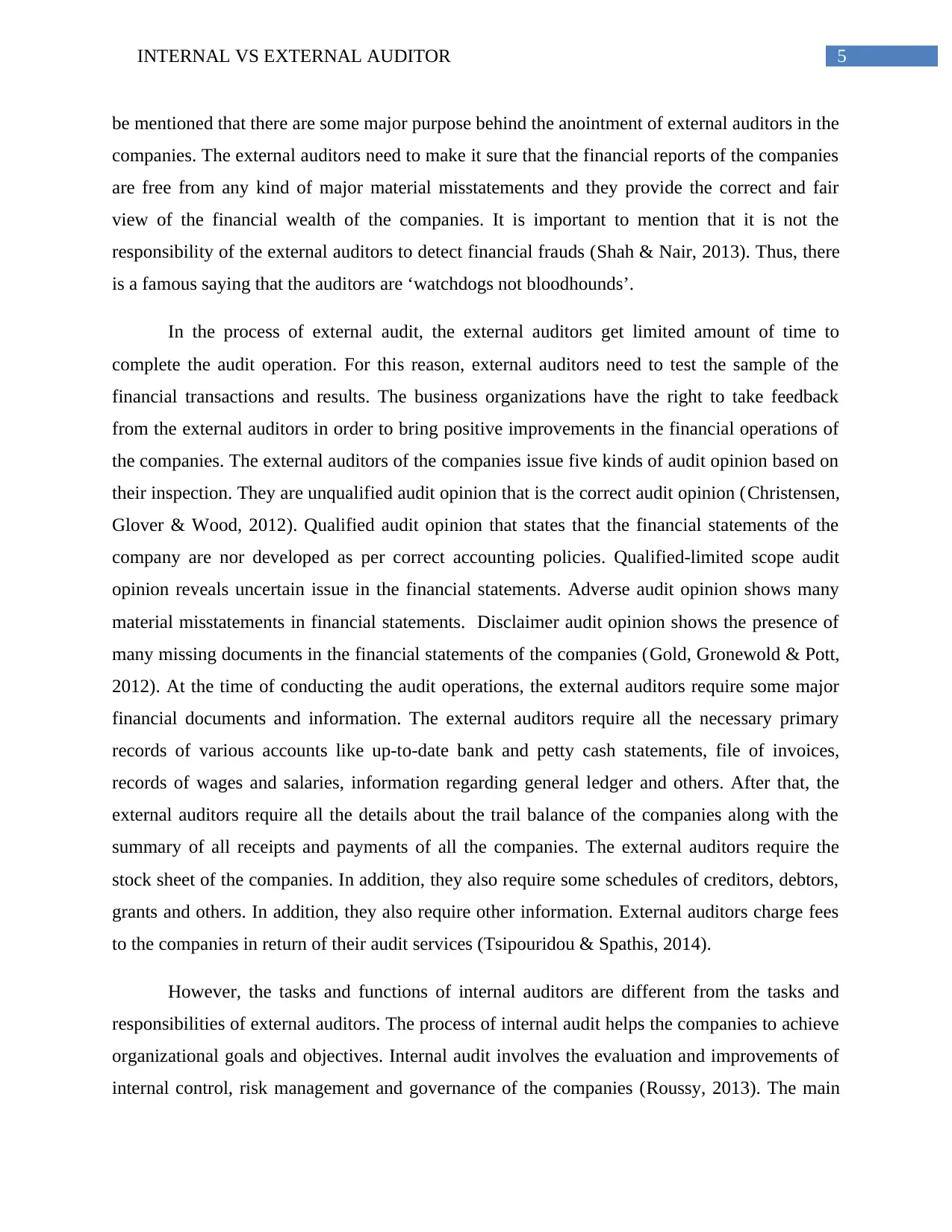
5INTERNAL VS EXTERNAL AUDITOR
be mentioned that there are some major purpose behind the anointment of external auditors in the
companies. The external auditors need to make it sure that the financial reports of the companies
are free from any kind of major material misstatements and they provide the correct and fair
view of the financial wealth of the companies. It is important to mention that it is not the
responsibility of the external auditors to detect financial frauds (Shah & Nair, 2013). Thus, there
is a famous saying that the auditors are ‘watchdogs not bloodhounds’.
In the process of external audit, the external auditors get limited amount of time to
complete the audit operation. For this reason, external auditors need to test the sample of the
financial transactions and results. The business organizations have the right to take feedback
from the external auditors in order to bring positive improvements in the financial operations of
the companies. The external auditors of the companies issue five kinds of audit opinion based on
their inspection. They are unqualified audit opinion that is the correct audit opinion (Christensen,
Glover & Wood, 2012). Qualified audit opinion that states that the financial statements of the
company are nor developed as per correct accounting policies. Qualified-limited scope audit
opinion reveals uncertain issue in the financial statements. Adverse audit opinion shows many
material misstatements in financial statements. Disclaimer audit opinion shows the presence of
many missing documents in the financial statements of the companies (Gold, Gronewold & Pott,
2012). At the time of conducting the audit operations, the external auditors require some major
financial documents and information. The external auditors require all the necessary primary
records of various accounts like up-to-date bank and petty cash statements, file of invoices,
records of wages and salaries, information regarding general ledger and others. After that, the
external auditors require all the details about the trail balance of the companies along with the
summary of all receipts and payments of all the companies. The external auditors require the
stock sheet of the companies. In addition, they also require some schedules of creditors, debtors,
grants and others. In addition, they also require other information. External auditors charge fees
to the companies in return of their audit services (Tsipouridou & Spathis, 2014).
However, the tasks and functions of internal auditors are different from the tasks and
responsibilities of external auditors. The process of internal audit helps the companies to achieve
organizational goals and objectives. Internal audit involves the evaluation and improvements of
internal control, risk management and governance of the companies (Roussy, 2013). The main
be mentioned that there are some major purpose behind the anointment of external auditors in the
companies. The external auditors need to make it sure that the financial reports of the companies
are free from any kind of major material misstatements and they provide the correct and fair
view of the financial wealth of the companies. It is important to mention that it is not the
responsibility of the external auditors to detect financial frauds (Shah & Nair, 2013). Thus, there
is a famous saying that the auditors are ‘watchdogs not bloodhounds’.
In the process of external audit, the external auditors get limited amount of time to
complete the audit operation. For this reason, external auditors need to test the sample of the
financial transactions and results. The business organizations have the right to take feedback
from the external auditors in order to bring positive improvements in the financial operations of
the companies. The external auditors of the companies issue five kinds of audit opinion based on
their inspection. They are unqualified audit opinion that is the correct audit opinion (Christensen,
Glover & Wood, 2012). Qualified audit opinion that states that the financial statements of the
company are nor developed as per correct accounting policies. Qualified-limited scope audit
opinion reveals uncertain issue in the financial statements. Adverse audit opinion shows many
material misstatements in financial statements. Disclaimer audit opinion shows the presence of
many missing documents in the financial statements of the companies (Gold, Gronewold & Pott,
2012). At the time of conducting the audit operations, the external auditors require some major
financial documents and information. The external auditors require all the necessary primary
records of various accounts like up-to-date bank and petty cash statements, file of invoices,
records of wages and salaries, information regarding general ledger and others. After that, the
external auditors require all the details about the trail balance of the companies along with the
summary of all receipts and payments of all the companies. The external auditors require the
stock sheet of the companies. In addition, they also require some schedules of creditors, debtors,
grants and others. In addition, they also require other information. External auditors charge fees
to the companies in return of their audit services (Tsipouridou & Spathis, 2014).
However, the tasks and functions of internal auditors are different from the tasks and
responsibilities of external auditors. The process of internal audit helps the companies to achieve
organizational goals and objectives. Internal audit involves the evaluation and improvements of
internal control, risk management and governance of the companies (Roussy, 2013). The main
⊘ This is a preview!⊘
Do you want full access?
Subscribe today to unlock all pages.

Trusted by 1+ million students worldwide
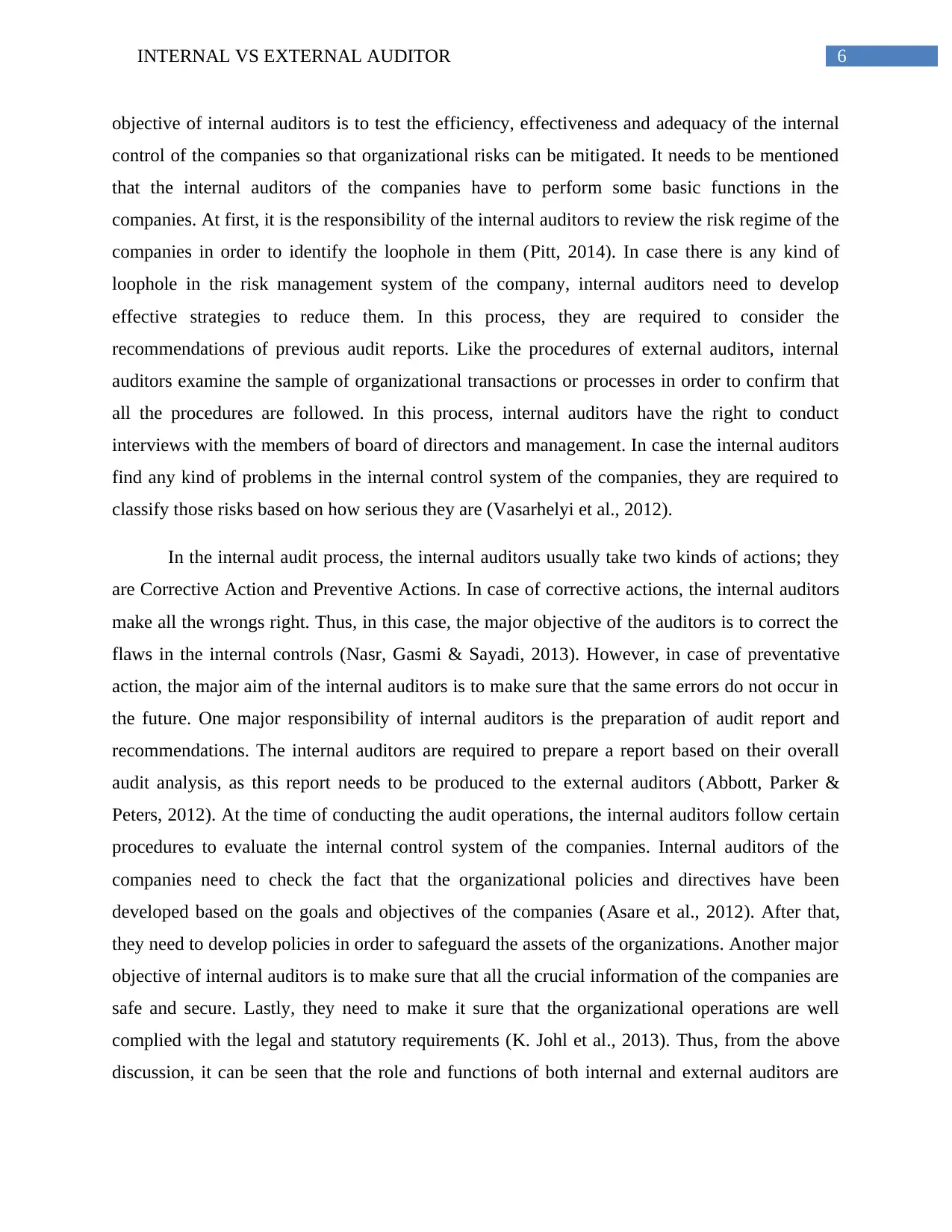
6INTERNAL VS EXTERNAL AUDITOR
objective of internal auditors is to test the efficiency, effectiveness and adequacy of the internal
control of the companies so that organizational risks can be mitigated. It needs to be mentioned
that the internal auditors of the companies have to perform some basic functions in the
companies. At first, it is the responsibility of the internal auditors to review the risk regime of the
companies in order to identify the loophole in them (Pitt, 2014). In case there is any kind of
loophole in the risk management system of the company, internal auditors need to develop
effective strategies to reduce them. In this process, they are required to consider the
recommendations of previous audit reports. Like the procedures of external auditors, internal
auditors examine the sample of organizational transactions or processes in order to confirm that
all the procedures are followed. In this process, internal auditors have the right to conduct
interviews with the members of board of directors and management. In case the internal auditors
find any kind of problems in the internal control system of the companies, they are required to
classify those risks based on how serious they are (Vasarhelyi et al., 2012).
In the internal audit process, the internal auditors usually take two kinds of actions; they
are Corrective Action and Preventive Actions. In case of corrective actions, the internal auditors
make all the wrongs right. Thus, in this case, the major objective of the auditors is to correct the
flaws in the internal controls (Nasr, Gasmi & Sayadi, 2013). However, in case of preventative
action, the major aim of the internal auditors is to make sure that the same errors do not occur in
the future. One major responsibility of internal auditors is the preparation of audit report and
recommendations. The internal auditors are required to prepare a report based on their overall
audit analysis, as this report needs to be produced to the external auditors (Abbott, Parker &
Peters, 2012). At the time of conducting the audit operations, the internal auditors follow certain
procedures to evaluate the internal control system of the companies. Internal auditors of the
companies need to check the fact that the organizational policies and directives have been
developed based on the goals and objectives of the companies (Asare et al., 2012). After that,
they need to develop policies in order to safeguard the assets of the organizations. Another major
objective of internal auditors is to make sure that all the crucial information of the companies are
safe and secure. Lastly, they need to make it sure that the organizational operations are well
complied with the legal and statutory requirements (K. Johl et al., 2013). Thus, from the above
discussion, it can be seen that the role and functions of both internal and external auditors are
objective of internal auditors is to test the efficiency, effectiveness and adequacy of the internal
control of the companies so that organizational risks can be mitigated. It needs to be mentioned
that the internal auditors of the companies have to perform some basic functions in the
companies. At first, it is the responsibility of the internal auditors to review the risk regime of the
companies in order to identify the loophole in them (Pitt, 2014). In case there is any kind of
loophole in the risk management system of the company, internal auditors need to develop
effective strategies to reduce them. In this process, they are required to consider the
recommendations of previous audit reports. Like the procedures of external auditors, internal
auditors examine the sample of organizational transactions or processes in order to confirm that
all the procedures are followed. In this process, internal auditors have the right to conduct
interviews with the members of board of directors and management. In case the internal auditors
find any kind of problems in the internal control system of the companies, they are required to
classify those risks based on how serious they are (Vasarhelyi et al., 2012).
In the internal audit process, the internal auditors usually take two kinds of actions; they
are Corrective Action and Preventive Actions. In case of corrective actions, the internal auditors
make all the wrongs right. Thus, in this case, the major objective of the auditors is to correct the
flaws in the internal controls (Nasr, Gasmi & Sayadi, 2013). However, in case of preventative
action, the major aim of the internal auditors is to make sure that the same errors do not occur in
the future. One major responsibility of internal auditors is the preparation of audit report and
recommendations. The internal auditors are required to prepare a report based on their overall
audit analysis, as this report needs to be produced to the external auditors (Abbott, Parker &
Peters, 2012). At the time of conducting the audit operations, the internal auditors follow certain
procedures to evaluate the internal control system of the companies. Internal auditors of the
companies need to check the fact that the organizational policies and directives have been
developed based on the goals and objectives of the companies (Asare et al., 2012). After that,
they need to develop policies in order to safeguard the assets of the organizations. Another major
objective of internal auditors is to make sure that all the crucial information of the companies are
safe and secure. Lastly, they need to make it sure that the organizational operations are well
complied with the legal and statutory requirements (K. Johl et al., 2013). Thus, from the above
discussion, it can be seen that the role and functions of both internal and external auditors are
Paraphrase This Document
Need a fresh take? Get an instant paraphrase of this document with our AI Paraphraser
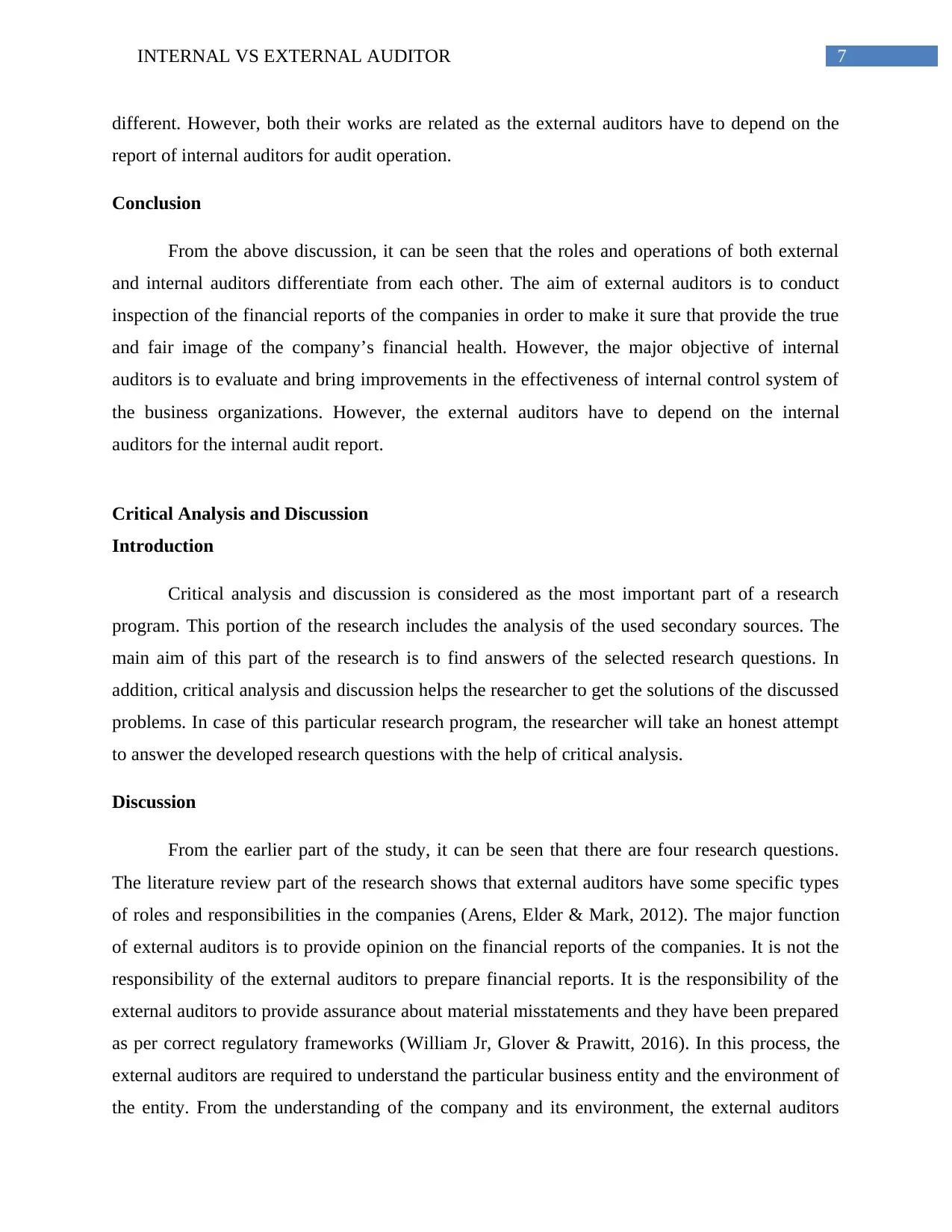
7INTERNAL VS EXTERNAL AUDITOR
different. However, both their works are related as the external auditors have to depend on the
report of internal auditors for audit operation.
Conclusion
From the above discussion, it can be seen that the roles and operations of both external
and internal auditors differentiate from each other. The aim of external auditors is to conduct
inspection of the financial reports of the companies in order to make it sure that provide the true
and fair image of the company’s financial health. However, the major objective of internal
auditors is to evaluate and bring improvements in the effectiveness of internal control system of
the business organizations. However, the external auditors have to depend on the internal
auditors for the internal audit report.
Critical Analysis and Discussion
Introduction
Critical analysis and discussion is considered as the most important part of a research
program. This portion of the research includes the analysis of the used secondary sources. The
main aim of this part of the research is to find answers of the selected research questions. In
addition, critical analysis and discussion helps the researcher to get the solutions of the discussed
problems. In case of this particular research program, the researcher will take an honest attempt
to answer the developed research questions with the help of critical analysis.
Discussion
From the earlier part of the study, it can be seen that there are four research questions.
The literature review part of the research shows that external auditors have some specific types
of roles and responsibilities in the companies (Arens, Elder & Mark, 2012). The major function
of external auditors is to provide opinion on the financial reports of the companies. It is not the
responsibility of the external auditors to prepare financial reports. It is the responsibility of the
external auditors to provide assurance about material misstatements and they have been prepared
as per correct regulatory frameworks (William Jr, Glover & Prawitt, 2016). In this process, the
external auditors are required to understand the particular business entity and the environment of
the entity. From the understanding of the company and its environment, the external auditors
different. However, both their works are related as the external auditors have to depend on the
report of internal auditors for audit operation.
Conclusion
From the above discussion, it can be seen that the roles and operations of both external
and internal auditors differentiate from each other. The aim of external auditors is to conduct
inspection of the financial reports of the companies in order to make it sure that provide the true
and fair image of the company’s financial health. However, the major objective of internal
auditors is to evaluate and bring improvements in the effectiveness of internal control system of
the business organizations. However, the external auditors have to depend on the internal
auditors for the internal audit report.
Critical Analysis and Discussion
Introduction
Critical analysis and discussion is considered as the most important part of a research
program. This portion of the research includes the analysis of the used secondary sources. The
main aim of this part of the research is to find answers of the selected research questions. In
addition, critical analysis and discussion helps the researcher to get the solutions of the discussed
problems. In case of this particular research program, the researcher will take an honest attempt
to answer the developed research questions with the help of critical analysis.
Discussion
From the earlier part of the study, it can be seen that there are four research questions.
The literature review part of the research shows that external auditors have some specific types
of roles and responsibilities in the companies (Arens, Elder & Mark, 2012). The major function
of external auditors is to provide opinion on the financial reports of the companies. It is not the
responsibility of the external auditors to prepare financial reports. It is the responsibility of the
external auditors to provide assurance about material misstatements and they have been prepared
as per correct regulatory frameworks (William Jr, Glover & Prawitt, 2016). In this process, the
external auditors are required to understand the particular business entity and the environment of
the entity. From the understanding of the company and its environment, the external auditors
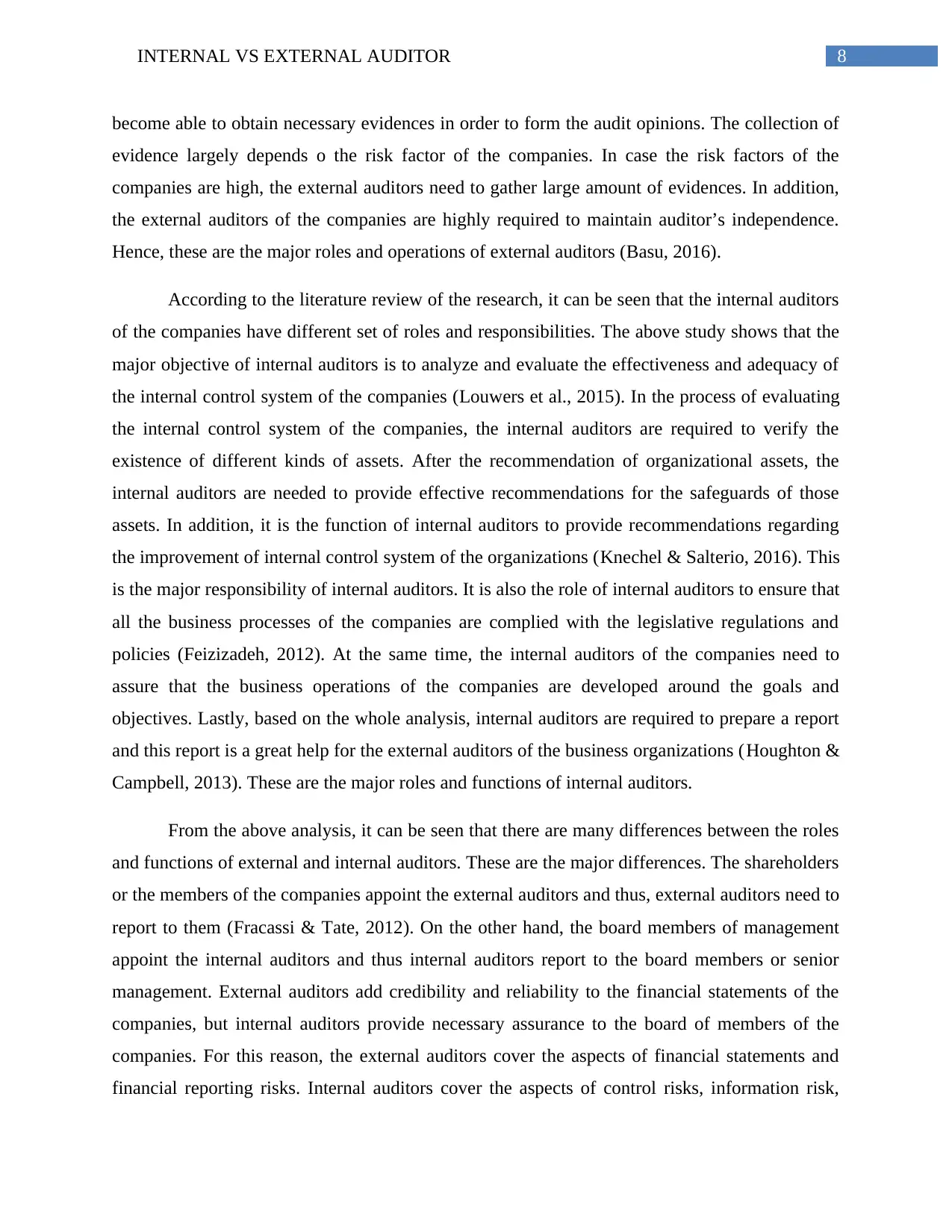
8INTERNAL VS EXTERNAL AUDITOR
become able to obtain necessary evidences in order to form the audit opinions. The collection of
evidence largely depends o the risk factor of the companies. In case the risk factors of the
companies are high, the external auditors need to gather large amount of evidences. In addition,
the external auditors of the companies are highly required to maintain auditor’s independence.
Hence, these are the major roles and operations of external auditors (Basu, 2016).
According to the literature review of the research, it can be seen that the internal auditors
of the companies have different set of roles and responsibilities. The above study shows that the
major objective of internal auditors is to analyze and evaluate the effectiveness and adequacy of
the internal control system of the companies (Louwers et al., 2015). In the process of evaluating
the internal control system of the companies, the internal auditors are required to verify the
existence of different kinds of assets. After the recommendation of organizational assets, the
internal auditors are needed to provide effective recommendations for the safeguards of those
assets. In addition, it is the function of internal auditors to provide recommendations regarding
the improvement of internal control system of the organizations (Knechel & Salterio, 2016). This
is the major responsibility of internal auditors. It is also the role of internal auditors to ensure that
all the business processes of the companies are complied with the legislative regulations and
policies (Feizizadeh, 2012). At the same time, the internal auditors of the companies need to
assure that the business operations of the companies are developed around the goals and
objectives. Lastly, based on the whole analysis, internal auditors are required to prepare a report
and this report is a great help for the external auditors of the business organizations (Houghton &
Campbell, 2013). These are the major roles and functions of internal auditors.
From the above analysis, it can be seen that there are many differences between the roles
and functions of external and internal auditors. These are the major differences. The shareholders
or the members of the companies appoint the external auditors and thus, external auditors need to
report to them (Fracassi & Tate, 2012). On the other hand, the board members of management
appoint the internal auditors and thus internal auditors report to the board members or senior
management. External auditors add credibility and reliability to the financial statements of the
companies, but internal auditors provide necessary assurance to the board of members of the
companies. For this reason, the external auditors cover the aspects of financial statements and
financial reporting risks. Internal auditors cover the aspects of control risks, information risk,
become able to obtain necessary evidences in order to form the audit opinions. The collection of
evidence largely depends o the risk factor of the companies. In case the risk factors of the
companies are high, the external auditors need to gather large amount of evidences. In addition,
the external auditors of the companies are highly required to maintain auditor’s independence.
Hence, these are the major roles and operations of external auditors (Basu, 2016).
According to the literature review of the research, it can be seen that the internal auditors
of the companies have different set of roles and responsibilities. The above study shows that the
major objective of internal auditors is to analyze and evaluate the effectiveness and adequacy of
the internal control system of the companies (Louwers et al., 2015). In the process of evaluating
the internal control system of the companies, the internal auditors are required to verify the
existence of different kinds of assets. After the recommendation of organizational assets, the
internal auditors are needed to provide effective recommendations for the safeguards of those
assets. In addition, it is the function of internal auditors to provide recommendations regarding
the improvement of internal control system of the organizations (Knechel & Salterio, 2016). This
is the major responsibility of internal auditors. It is also the role of internal auditors to ensure that
all the business processes of the companies are complied with the legislative regulations and
policies (Feizizadeh, 2012). At the same time, the internal auditors of the companies need to
assure that the business operations of the companies are developed around the goals and
objectives. Lastly, based on the whole analysis, internal auditors are required to prepare a report
and this report is a great help for the external auditors of the business organizations (Houghton &
Campbell, 2013). These are the major roles and functions of internal auditors.
From the above analysis, it can be seen that there are many differences between the roles
and functions of external and internal auditors. These are the major differences. The shareholders
or the members of the companies appoint the external auditors and thus, external auditors need to
report to them (Fracassi & Tate, 2012). On the other hand, the board members of management
appoint the internal auditors and thus internal auditors report to the board members or senior
management. External auditors add credibility and reliability to the financial statements of the
companies, but internal auditors provide necessary assurance to the board of members of the
companies. For this reason, the external auditors cover the aspects of financial statements and
financial reporting risks. Internal auditors cover the aspects of control risks, information risk,
⊘ This is a preview!⊘
Do you want full access?
Subscribe today to unlock all pages.

Trusted by 1+ million students worldwide
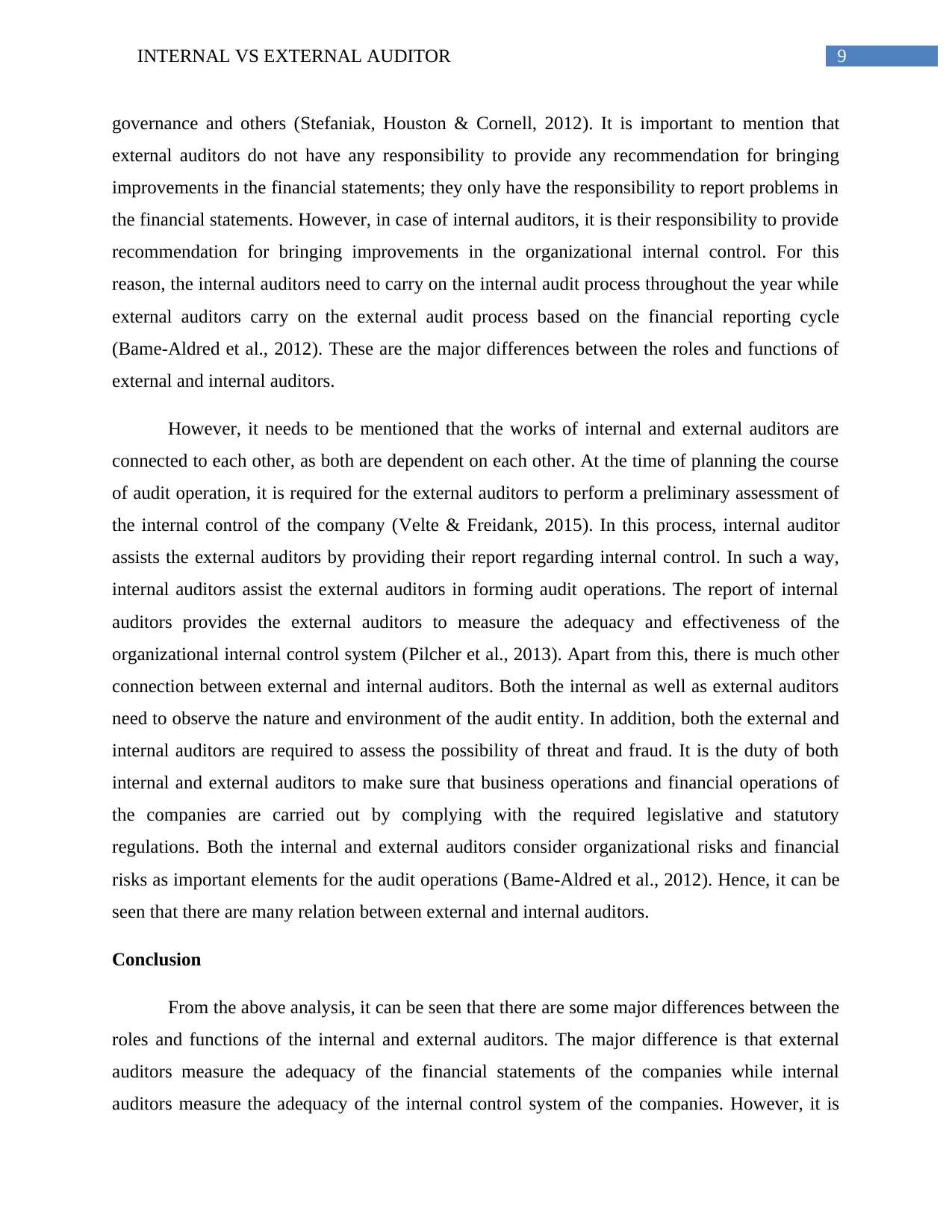
9INTERNAL VS EXTERNAL AUDITOR
governance and others (Stefaniak, Houston & Cornell, 2012). It is important to mention that
external auditors do not have any responsibility to provide any recommendation for bringing
improvements in the financial statements; they only have the responsibility to report problems in
the financial statements. However, in case of internal auditors, it is their responsibility to provide
recommendation for bringing improvements in the organizational internal control. For this
reason, the internal auditors need to carry on the internal audit process throughout the year while
external auditors carry on the external audit process based on the financial reporting cycle
(Bame-Aldred et al., 2012). These are the major differences between the roles and functions of
external and internal auditors.
However, it needs to be mentioned that the works of internal and external auditors are
connected to each other, as both are dependent on each other. At the time of planning the course
of audit operation, it is required for the external auditors to perform a preliminary assessment of
the internal control of the company (Velte & Freidank, 2015). In this process, internal auditor
assists the external auditors by providing their report regarding internal control. In such a way,
internal auditors assist the external auditors in forming audit operations. The report of internal
auditors provides the external auditors to measure the adequacy and effectiveness of the
organizational internal control system (Pilcher et al., 2013). Apart from this, there is much other
connection between external and internal auditors. Both the internal as well as external auditors
need to observe the nature and environment of the audit entity. In addition, both the external and
internal auditors are required to assess the possibility of threat and fraud. It is the duty of both
internal and external auditors to make sure that business operations and financial operations of
the companies are carried out by complying with the required legislative and statutory
regulations. Both the internal and external auditors consider organizational risks and financial
risks as important elements for the audit operations (Bame-Aldred et al., 2012). Hence, it can be
seen that there are many relation between external and internal auditors.
Conclusion
From the above analysis, it can be seen that there are some major differences between the
roles and functions of the internal and external auditors. The major difference is that external
auditors measure the adequacy of the financial statements of the companies while internal
auditors measure the adequacy of the internal control system of the companies. However, it is
governance and others (Stefaniak, Houston & Cornell, 2012). It is important to mention that
external auditors do not have any responsibility to provide any recommendation for bringing
improvements in the financial statements; they only have the responsibility to report problems in
the financial statements. However, in case of internal auditors, it is their responsibility to provide
recommendation for bringing improvements in the organizational internal control. For this
reason, the internal auditors need to carry on the internal audit process throughout the year while
external auditors carry on the external audit process based on the financial reporting cycle
(Bame-Aldred et al., 2012). These are the major differences between the roles and functions of
external and internal auditors.
However, it needs to be mentioned that the works of internal and external auditors are
connected to each other, as both are dependent on each other. At the time of planning the course
of audit operation, it is required for the external auditors to perform a preliminary assessment of
the internal control of the company (Velte & Freidank, 2015). In this process, internal auditor
assists the external auditors by providing their report regarding internal control. In such a way,
internal auditors assist the external auditors in forming audit operations. The report of internal
auditors provides the external auditors to measure the adequacy and effectiveness of the
organizational internal control system (Pilcher et al., 2013). Apart from this, there is much other
connection between external and internal auditors. Both the internal as well as external auditors
need to observe the nature and environment of the audit entity. In addition, both the external and
internal auditors are required to assess the possibility of threat and fraud. It is the duty of both
internal and external auditors to make sure that business operations and financial operations of
the companies are carried out by complying with the required legislative and statutory
regulations. Both the internal and external auditors consider organizational risks and financial
risks as important elements for the audit operations (Bame-Aldred et al., 2012). Hence, it can be
seen that there are many relation between external and internal auditors.
Conclusion
From the above analysis, it can be seen that there are some major differences between the
roles and functions of the internal and external auditors. The major difference is that external
auditors measure the adequacy of the financial statements of the companies while internal
auditors measure the adequacy of the internal control system of the companies. However, it is
Paraphrase This Document
Need a fresh take? Get an instant paraphrase of this document with our AI Paraphraser
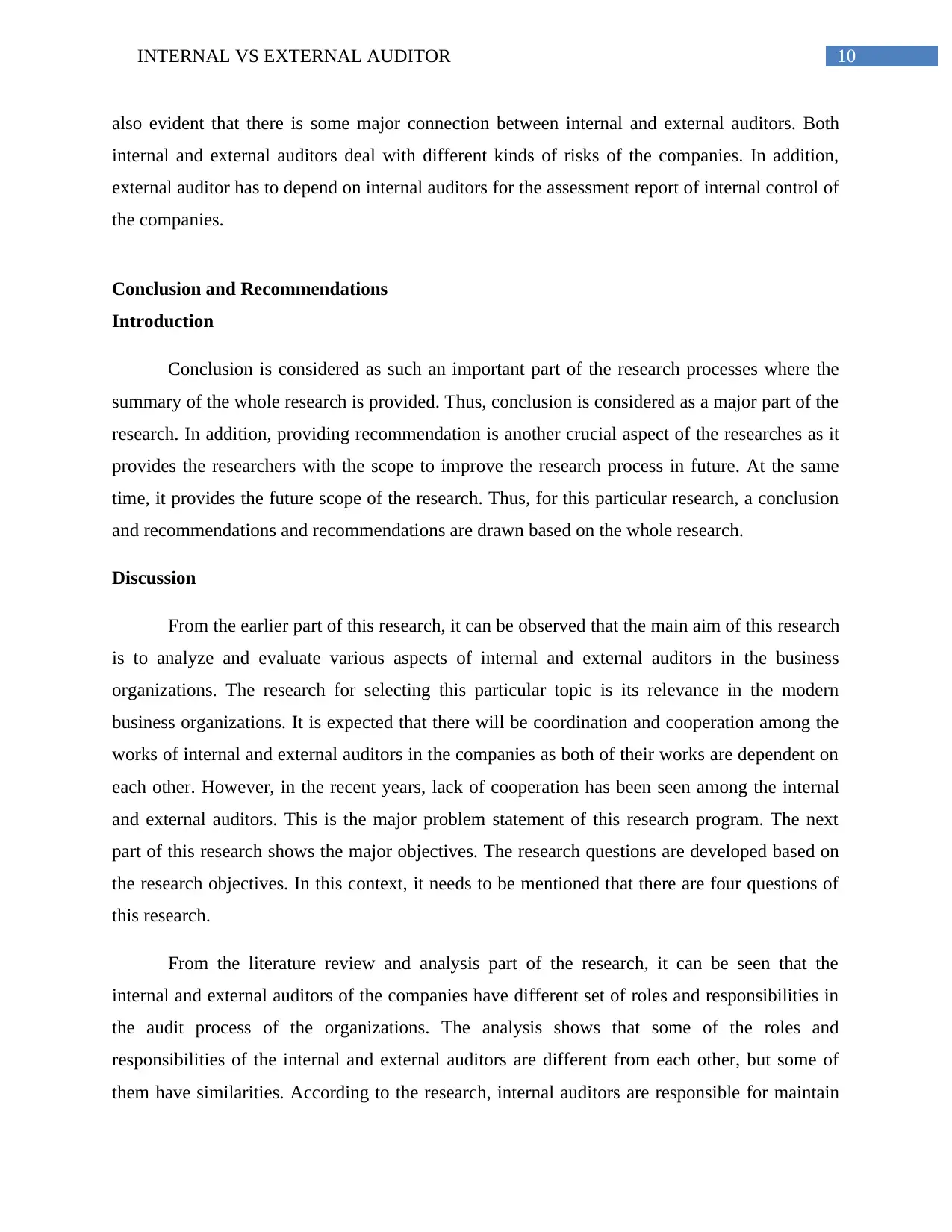
10INTERNAL VS EXTERNAL AUDITOR
also evident that there is some major connection between internal and external auditors. Both
internal and external auditors deal with different kinds of risks of the companies. In addition,
external auditor has to depend on internal auditors for the assessment report of internal control of
the companies.
Conclusion and Recommendations
Introduction
Conclusion is considered as such an important part of the research processes where the
summary of the whole research is provided. Thus, conclusion is considered as a major part of the
research. In addition, providing recommendation is another crucial aspect of the researches as it
provides the researchers with the scope to improve the research process in future. At the same
time, it provides the future scope of the research. Thus, for this particular research, a conclusion
and recommendations and recommendations are drawn based on the whole research.
Discussion
From the earlier part of this research, it can be observed that the main aim of this research
is to analyze and evaluate various aspects of internal and external auditors in the business
organizations. The research for selecting this particular topic is its relevance in the modern
business organizations. It is expected that there will be coordination and cooperation among the
works of internal and external auditors in the companies as both of their works are dependent on
each other. However, in the recent years, lack of cooperation has been seen among the internal
and external auditors. This is the major problem statement of this research program. The next
part of this research shows the major objectives. The research questions are developed based on
the research objectives. In this context, it needs to be mentioned that there are four questions of
this research.
From the literature review and analysis part of the research, it can be seen that the
internal and external auditors of the companies have different set of roles and responsibilities in
the audit process of the organizations. The analysis shows that some of the roles and
responsibilities of the internal and external auditors are different from each other, but some of
them have similarities. According to the research, internal auditors are responsible for maintain
also evident that there is some major connection between internal and external auditors. Both
internal and external auditors deal with different kinds of risks of the companies. In addition,
external auditor has to depend on internal auditors for the assessment report of internal control of
the companies.
Conclusion and Recommendations
Introduction
Conclusion is considered as such an important part of the research processes where the
summary of the whole research is provided. Thus, conclusion is considered as a major part of the
research. In addition, providing recommendation is another crucial aspect of the researches as it
provides the researchers with the scope to improve the research process in future. At the same
time, it provides the future scope of the research. Thus, for this particular research, a conclusion
and recommendations and recommendations are drawn based on the whole research.
Discussion
From the earlier part of this research, it can be observed that the main aim of this research
is to analyze and evaluate various aspects of internal and external auditors in the business
organizations. The research for selecting this particular topic is its relevance in the modern
business organizations. It is expected that there will be coordination and cooperation among the
works of internal and external auditors in the companies as both of their works are dependent on
each other. However, in the recent years, lack of cooperation has been seen among the internal
and external auditors. This is the major problem statement of this research program. The next
part of this research shows the major objectives. The research questions are developed based on
the research objectives. In this context, it needs to be mentioned that there are four questions of
this research.
From the literature review and analysis part of the research, it can be seen that the
internal and external auditors of the companies have different set of roles and responsibilities in
the audit process of the organizations. The analysis shows that some of the roles and
responsibilities of the internal and external auditors are different from each other, but some of
them have similarities. According to the research, internal auditors are responsible for maintain
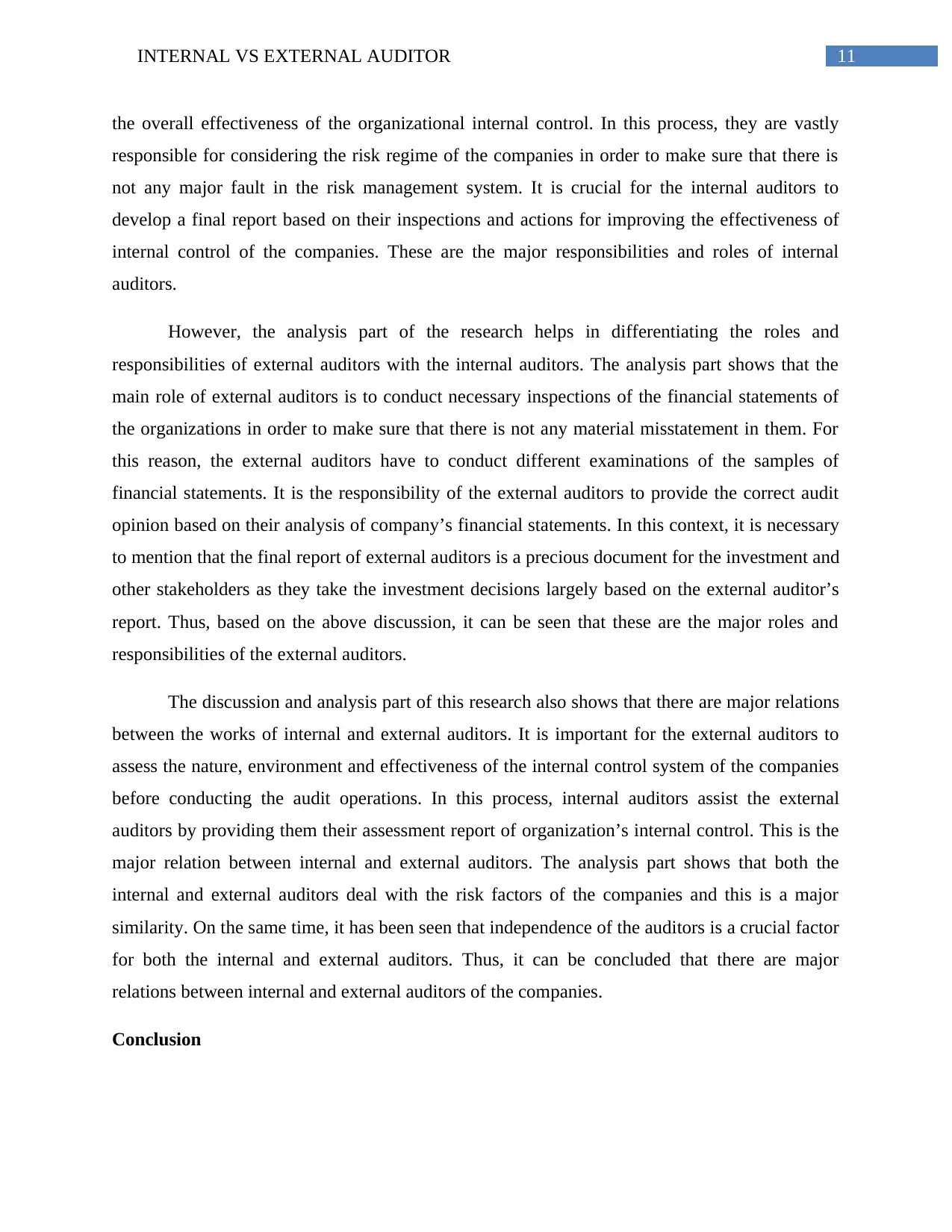
11INTERNAL VS EXTERNAL AUDITOR
the overall effectiveness of the organizational internal control. In this process, they are vastly
responsible for considering the risk regime of the companies in order to make sure that there is
not any major fault in the risk management system. It is crucial for the internal auditors to
develop a final report based on their inspections and actions for improving the effectiveness of
internal control of the companies. These are the major responsibilities and roles of internal
auditors.
However, the analysis part of the research helps in differentiating the roles and
responsibilities of external auditors with the internal auditors. The analysis part shows that the
main role of external auditors is to conduct necessary inspections of the financial statements of
the organizations in order to make sure that there is not any material misstatement in them. For
this reason, the external auditors have to conduct different examinations of the samples of
financial statements. It is the responsibility of the external auditors to provide the correct audit
opinion based on their analysis of company’s financial statements. In this context, it is necessary
to mention that the final report of external auditors is a precious document for the investment and
other stakeholders as they take the investment decisions largely based on the external auditor’s
report. Thus, based on the above discussion, it can be seen that these are the major roles and
responsibilities of the external auditors.
The discussion and analysis part of this research also shows that there are major relations
between the works of internal and external auditors. It is important for the external auditors to
assess the nature, environment and effectiveness of the internal control system of the companies
before conducting the audit operations. In this process, internal auditors assist the external
auditors by providing them their assessment report of organization’s internal control. This is the
major relation between internal and external auditors. The analysis part shows that both the
internal and external auditors deal with the risk factors of the companies and this is a major
similarity. On the same time, it has been seen that independence of the auditors is a crucial factor
for both the internal and external auditors. Thus, it can be concluded that there are major
relations between internal and external auditors of the companies.
Conclusion
the overall effectiveness of the organizational internal control. In this process, they are vastly
responsible for considering the risk regime of the companies in order to make sure that there is
not any major fault in the risk management system. It is crucial for the internal auditors to
develop a final report based on their inspections and actions for improving the effectiveness of
internal control of the companies. These are the major responsibilities and roles of internal
auditors.
However, the analysis part of the research helps in differentiating the roles and
responsibilities of external auditors with the internal auditors. The analysis part shows that the
main role of external auditors is to conduct necessary inspections of the financial statements of
the organizations in order to make sure that there is not any material misstatement in them. For
this reason, the external auditors have to conduct different examinations of the samples of
financial statements. It is the responsibility of the external auditors to provide the correct audit
opinion based on their analysis of company’s financial statements. In this context, it is necessary
to mention that the final report of external auditors is a precious document for the investment and
other stakeholders as they take the investment decisions largely based on the external auditor’s
report. Thus, based on the above discussion, it can be seen that these are the major roles and
responsibilities of the external auditors.
The discussion and analysis part of this research also shows that there are major relations
between the works of internal and external auditors. It is important for the external auditors to
assess the nature, environment and effectiveness of the internal control system of the companies
before conducting the audit operations. In this process, internal auditors assist the external
auditors by providing them their assessment report of organization’s internal control. This is the
major relation between internal and external auditors. The analysis part shows that both the
internal and external auditors deal with the risk factors of the companies and this is a major
similarity. On the same time, it has been seen that independence of the auditors is a crucial factor
for both the internal and external auditors. Thus, it can be concluded that there are major
relations between internal and external auditors of the companies.
Conclusion
⊘ This is a preview!⊘
Do you want full access?
Subscribe today to unlock all pages.

Trusted by 1+ million students worldwide
1 out of 16
Related Documents
Your All-in-One AI-Powered Toolkit for Academic Success.
+13062052269
info@desklib.com
Available 24*7 on WhatsApp / Email
![[object Object]](/_next/static/media/star-bottom.7253800d.svg)
Unlock your academic potential
Copyright © 2020–2025 A2Z Services. All Rights Reserved. Developed and managed by ZUCOL.





